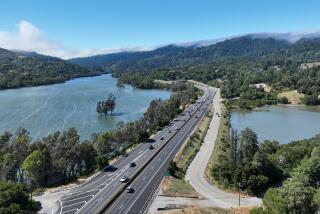Vail Hails Roundabout Way to Ease Traffic : In Colorado, California and elsewhere in U.S., highway circles are getting a positive spin.
- Share via
VAIL, Colo. — Zipping off the freeway at 55 mph, you enter Vail’s freeway offramp looking for a signal or stop sign out of habit. Before realizing where you are supposed to turn, you are engulfed in a whirlpool of buses, trucks and cars.
Unless you’ve driven in Britain, getting swept up in the merry-go-round of traffic inside Vail’s roundabout freeway interchange--North America’s first--can be unnerving.
For newcomers, the curious thing about the asphalt doughnuts--one on either side of Interstate 70 at the entrance to one of America’s top ski resorts--is that they manage to funnel traffic in and out each day without major delays or accidents.
Since the $2.8-million project replaced a four-way-stop intersection a year ago, it has increased capacity by 56%, eliminated delays on roads where half-mile queues once backed up into special holding lanes, and saved the city $85,000 a year by ending the need for five traffic police. Accidents with injuries are down 75%. Vail aims to build another roundabout next year.
Vail’s roundabouts already have elevated the stature of the concept throughout the Rocky Mountains, where ranching communities are being transformed into major recreational and commercial centers.
In the neighboring town of Avon, voters on Nov. 5 overwhelmingly approved a plan to increase their property taxes to pay for construction of five roundabouts, including two at a freeway interchange.
They are not being built for the sake of quaintness. Rather, highway engineers say the roundabouts are a practical solution to delays, dents and high-maintenance signal lights that consume $3,000 worth of electricity apiece annually.
“We’re taking a big chance. After all, this is a permanent fix,” said former Avon Mayor Albert “Buz” Reynolds, who helped shepherd the $3.5-million project.
“If they don’t work, we’ll be famous as the guys who flopped next door to Vail,” he said.
By the end of next year, Reynold’s pint-sized town will have one roundabout for every 520 residents, the highest per capita rate in the Western Hemisphere.
How well the extremely complicated highway technology performs in the 30-mile-long Vail Valley may determine whether dozens, perhaps hundreds, more are built from California to Maryland.
“We’ll be keeping an eye on it. . . . It may have something to teach us,” said Jerry Champa, chief of geometric design standards for the California Department of Transportation.
“We are certainly not opposed to the concept,” Champa said. “We are simply proceeding cautiously in designing and building them because in the United States the track record isn’t there yet.”
The concept dominates highways in Europe, where Britain has 12,000 roundabouts. France is building them at a rate of 1,500 a year. Most contemporary designs follow a British right-of-way rule under which arriving motorists must yield to those inside the circle. Roads feeding a roundabout intersect the circle at an angle.
One such roundabout is in Long Beach. Another, smaller version was built in Santa Barbara in 1992. And two roundabouts are in the works in Calabasas, Calif., where traffic engineer Robert Yalda envies Vail’s success.
“I’m dying to see Vail’s roundabouts--even drive them 100 times!” exulted Yalda. “Only by feeling them, driving them, can I sell the notion in my city with real emotion and comfort.”
Santa Barbara consultant Leif Ourston, whose firm designed many of the roughly two dozen roundabouts now operating in the United States, is another who can hardly contain his enthusiasm for Vail Valley’s growing crop of circular road junctions.
“What we have there is a little valley that is bringing a shaft of light to an anachronistic society still wedded to signalized intersections,” Ourston said.
“We’ve had engineers come through from Loveland, Colo.; Wyoming; Iowa; Michigan; and the federal Highway Administration in Washington,” said Greg Hall, Vail’s town engineer. Yet, the concept is not foolproof.
On a recent night, a British waiter at a restaurant overlooking Vail’s roundabouts said the near-mishaps have become a “talking point” among patrons.
“See! That’s what I’m talking about,” said Jack Lacey, leaning over the balcony of Michael’s American Bistro. “That truck didn’t yield and just about smacked that white van. And look over there. That driver is stopping at each exit point to read street signs. Not a good deal.”
The owner of a gas station across the street mused that at least once a week “the horns go off; another driver freaked out and went around the wrong way.”
But, reminded Hall, “they work.”
(BEGIN TEXT OF INFOBOX / INFOGRAPHIC)
Round and Round
Traffic roundabouts are seen as a high-capacity, low-cost alternative to road widening.
Capacity: 6,000 vph*
Capacity: 4,300 vph*
* vehicles per hour
Source: Ourston & Doctors, Santa Barbara
More to Read
Sign up for Essential California
The most important California stories and recommendations in your inbox every morning.
You may occasionally receive promotional content from the Los Angeles Times.













